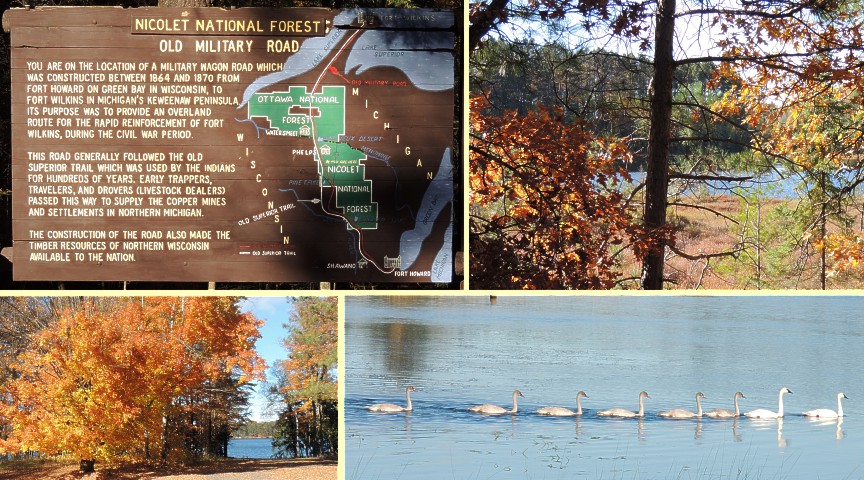Kansas Snapshots by Gloria Freeland - October 23, 2015
"Rich in new experiences"
The weather in Kansas had been unseasonably warm last week, so I was not mentally prepared when Husband Art picked me
up at the Wausau, Wisconsin airport late last Friday night. It was 38 and breezy. I put on the gloves I had shoved into
my pocket before leaving home. After a quick supper at Culver's, we traveled the 90 miles to our cottage.
Art had been at our cottage in Northern Wisconsin since mid-September, trout fishing and working on various
historical and home-improvement projects. We close the cottage for the season in October, but I always like to see the
woods and lakes one last time before the long, cold Wisconsin winter.
The temperatures had already been winter-like. In a text message a few days before, he said, "Weather today ... low 35
... with DRIZZLE." It was followed by, "Lows in mid-20s while you are here."
The black sky was filled with stars when we arrived. The temperature was near freezing, but inside our cottage was cozy
and welcoming.
Saturday morning presented a dusting of snow. Lake Superior's proximity makes weather forecasting unreliable. The day of
predicted cold rains was instead one of sun with a bright deep-blue sky. After a hearty bacon-and-eggs breakfast and a bit
of shopping, we jumped in Brown - Art's 32-year-old fishing car. I had donned a T-shirt, a long-sleeved shirt, a hooded
sweatshirt and a jacket to protect myself from the cold air.
The golf course, unlike during the summer when the area is populated by vacationers, was empty. We passed over the
bridge near Big Stone Lake. In the summer, the local water skiing club performs their shows there. Instead, there was a
lone boat with a hearty well-bundled fisherman was trying his luck in the clear, cold water.
We turned on Forest Road 2178 in the Chequamegon-Nicolet National Forest. We weren't disappointed. The bronze and
brilliant yellow oaks, red maples and soft yellow tamaracks, and the already-bare white birch trees were intermingled with
deep-green evergreens. It was such a contrast to the foliage of summer with its lush growth of varying shades of greens.
These white pine forests of Wisconsin provided the wood for many of the framed houses of Milwaukee, Chicago, St. Louis
and even New Orleans in the latter part of the nineteenth century. Logging had begun at the southern boundary even before
Wisconsin was a state and moved northward, arriving at the shore of Lake Superior in the late 1930s. Loggers clear cut
everything in their path. The land was left barren. It was then sold to settlers who used ox teams to clear the stumps.
But the soil in the northern half of the state is too poor to support farming. So the departure of the families of
failed farms and the work of the Civilian Conservation Corps during the Depression meant the woods in this area have
returned to what they were like when the white man first arrived. Wisconsin has over 15,000 lakes, just 200 less than
neighboring Minnesota. Many of those are in these northern woods.
We stopped to take pictures, but the breeze was chilly. Within minutes, my fingers felt frozen.
The road followed the "Old Military Trail." It had been planned during the Civil War to connect Fort Howard at what
would become Green Bay with Fort Wilkins in Upper Michigan's Keweenaw Peninsula where it juts out into Lake Superior. It
largely followed the Superior Trail the Native Americans used long before any white people arrived. Trappers, lumbermen,
traders, drovers and early pioneers also traveled on it.
Wisconsin had several military trails. In the September 1925 "Wisconsin Magazine of History," H.E. Cole described what
it was like to travel on one.
In that day when travel was limited, there was no treading on one another's heels; there was an inexpressible charm
about the deep solitudes along the way - the prairies fragrant and fascinating with a burst of brilliant bloom, the
radiant view gained after ascending a prominent elevation, the idyllic glory of the frontier region in autumn, and the
delectable charm of the lakes shimmering in the sunlight. Wild fowl filled the air in migratory flight, deer in herds
disappeared over many a hill, bears gave excitement from day to day, and at night the wolves uttered their nocturnal cry.
Every day was rich in new experiences for the traveler.
We weren't alone Saturday on the trail, but other vehicles were few and far between, and I could feel the "deep
solitudes along the way." The autumn colors and the lakes glittering in the sunlight captivated me, as they always do.
And then we saw something neither of us had seen before. As we approached Seven Mile Lake, we could see through the
trees some large white birds on the water. Upon reaching the clearing, we saw 30 or so trumpeter swans calmly feeding on
the vegetation near the water's edge. The adults were white with pure black beaks while the juveniles were grayish with
pink and black-tipped beaks. These majestic birds seemed little bothered by our presence. We took dozens of pictures.
Three other forest travelers stopped to gawk too.
Art told me we weren't likely to see them again in our lifetimes as we aren't there very often and they have many lakes
to choose from. I felt lucky that serendipity had led us to be at that spot on that day.
I didn't want to leave, but the sun was low and what light there was, was beginning to fade. It was getting colder. As
we retraced the route back to our cozy cottage, I reflected on the day. The trees of many colors, the deep blue sky, the
sun-dappled lakes and especially the trumpeter swans had made this day special. Cole's phrase came back to my mind again.
It had been a day "rich in new experiences."
